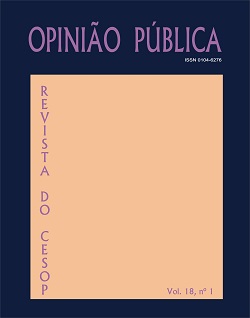Abstract
O principal objetivo desse artigo é apresentar uma introdução intuitiva à técnica de análise de conglomerados. Metodologicamente, utilizamos os dados de Coppedge, Alvarez e Maldonado (2008) sobre as duas dimensões da poliarquia propostas por Dahl (1971): contestação e inclusividade. A partir dessas dimensões os regimes políticos são classificados em diferentes grupos (clusters) de acordo com o grau de similaridade entre eles. Em termos substantivos,esperamos indicar uma ferramenta metodológica para classificação dos regimes políticos e facilitar a compreensão da técnica de análise de conglomerados na Ciência Política.
Abstract:
The principal aim of this paper is to provide a intuitive introduction to cluster analysis. Methodologically, we use data from Coppedge, Alvarez e Maldonado (2008) regarding the two dimensions of polyarchy proposed by Dahl (1971): contestation and inclusiveness. Based on these dimensions we classify political regimes in different groups (clusters) according to their similarity level. On substantive grounds, we hope to suggest a methodological tool to classify political regimes and facilitate the understanding of cluster analysis in Political Science.
Keywords: political regimes; cluster analysis; Q analysis; classification; quantitative methods
References
ALDENDERFER, M. S. e BLASHFIELD, R. K. “Cluster Analysis”. Sage University Paper Series: Quantitative Applications in the Social Science, 1984.
BAILEY, K. D. “Cluster Analysis”. Sociological Methodology, vol. 6, p. 59-128, 1975.
BERRY, B. J. L. and RAY, M. Multivariate socio-economic regionalization: A pilot study in central Canada. Unpublished manuscript. Department of Geography, University of Chicago, 1966.
BURTON, M. C. e ROMMEY, A. K. “A Multidimensional Representation of Role Terms”. American Ethnologist, v. 2, n.3, p.397-407, 1975.
COPPEDGE, M.; ALVAREZ, A.; MALDONADO, C. “Two Persistent Dimensions of Democracy: Contestation and Inclusiveness”. Journal of Politics, v. 70, n. 3, p. 1-45, 2008.
CZEKANOWSKI, J. “Objectiv Rriterien in der Ethnologie”. Korrespondenz-Blatt der Deutschen Gesellschaft fur Anthropologie, Ethnologie und Urgeschichte, 42, p.71-75, Hamburg, 1911.
DAHL, R. Poliarquia: Participação e Oposição. São Paulo: Edusp, 1971.
DANSECO, E. R.; HOLDEN, E. W. “Are There Different Types of Homeless Families? A Typology of Homeless Families Based On Cluster Analysis”. Family Relations, v. 47, n. 2, p. 159-165.
DOLNICAR, S. A review of unquestioned standards in used cluster analysis for data-driven market segmentation. Faculty of Commerce – Papers. 2002. Disponível em: < http://ro.uow.edu.au/commpapers/273 >.
DRIVER, H. E. Survey of numerical classification in anthropology. In: HYMES, D. (Ed.). The Use of Computers in Anthropology. The Hague: Mouton, 1965.
DRIVER, H. E.; KROEBER, A. L.Quantitative Expressions of Cultural Relationships. Berkeley: University of California Press, 1932.
EVERITT, B.S. Cluster Analysis. Second Edition, London: Heineman Educational Books Ltd, 1980.
FILSINGER, E.; FAULKNER, J. & WARLAND, R. “Empirical taxonomy of religious individuals: An investigation among college students”. Sociological Analysis, v. 40, 136-146, 1979.
FISHER, W. D. Clustering and Aggregation in Economics. Baltimore: Johns Hopkins, 1969.
FLEISHMAN, J. A. “Types of Political Attitude Structure: Results of a Cluster Analysis”. The Public Opinion Quarterly, v. 50, n. 3, p. 371-386, 1986.
FORMANN, A.K. Die Latent-Class-Analyse: Einführung in die Theorie und Anwendung. Weinheim: Beltz, 1984.
GARSON, G. D. Statnotes: Topics in Multivariate Analysis [online]. Disponível em: <http://faculty.chass.ncsu.edu/garson/PA765/statnote.htm> Acesso em 22 jan. 2010.
GOLDSTEIN, S. G. and LINDEN, J.“Multivariate Classification of alcoholics by means of MMPI”. Journal of abnormal Psychology, v. 14, n. 6, p. 661-669.
HAIR, Jr; BLACK, W. C; BABIN, B. J.; ANDERSON, R. E.; TATHAM, R. L. Análise Multivariada de Dados. Porto Alegre: Bookman, 2005.
HAIR, Jr; BLACK, W. C; BABIN, B. J.; ANDERSON, R. E.; TATHAM, R. L. Multivariate Data Analysis. 6ª edição. Upper Saddle River, NJ: Pearson Prentice Hall, 2006.
JOHNSON, S. “Hierarchical clustering schemes”. Psychometrika, 38, p.241-254, 1967.
KAISER, H. F. “An objective method for establishing legislative districts”. Midwest Journal of Political Science, v. 10, p. 200-213, 1966.
KING, G.; KEOHANE, R.; VERBA, S. Designing Social Inquiry: Scientific Inference in Qualitative Research, Princeton: Princeton university Press, 1994.
MACRAE, D. Jr. “Cluster Analysis of Congressional Votes with the BC TRY System”. The Western Political Quarterly, v. 19, n. 4, p. 631-638.
MAINWARING, S.; BRINKS, D.; PÉREZ-LIÑÁN, A. “Classificando Regimes Políticos na América Latina, 1945-1999”. Dados, v. 44, n. 4, 2001.
MOONEY, C. Z. “Bootstrap Statistical Inference: examples and evaluation for Political Science”. American Journal of Political Science, v. 40, n. 2, p. 570-602.
PETERS, W. S. “Cluster Analysis in Urban Demography”, Social Forces, v. 37, n. 1, p. 38-44, 1958.
POHLMANN, M. C. Análise de Conglomerados. In: CORRAR, L. J.; EDÍLSON, P.; DIAS FILHO, J. M. (Orgs.). Análise Multivariada. São Paulo: Atlas, 2007.
SANTOS, M. H; COUTINHO, M. ”Política comparada: estado das artes e perspectivas no Brasil”, BIB, v. 5, n. 4, p. 3-146, 2000.
SOARES, G. “O calcanhar metodológico da ciência política no Brasil”. Sociologia, Problemas e Práticas, v. II, n. 48, p. 27- 52, 2005.
SOKAL, R. R.; SNEATH, P. H. A. Principles of Numerical Taxonomy. San Francisco: W. H. Freeman, 1963.
TRYON, R. Cluster Analysis. New York: McGraw-Hill, 1939.
VALLE e SILVA, N. Relatório de Consultoria sobre Melhoria do Treinamento em Ciência Social Quantitativa e Aplicada no Brasil. Rio de Janeiro, Laboratório Nacional de Computação Científica, 1999.
VANNEMAN, R. “The Occupational Composition of American Classes: Results from Cluster Analysis”. The American Journal of Sociology, v. 82, n. 4, p. 783-807, 1977.
WERNECK VIANNA, L. et al. "Doutores e teses em ciências sociais", Dados, v. 41, n. 3, p. 453-515, 1998.
ZUBIN, J. A. "A technique for measuring likemindedness". Journal of Abnormal and Social Psychology, 33, p.508-516, Oct.1938.
A Opinião Pública utiliza a licença do Creative Commons (CC), preservando assim, a integridade dos artigos em ambiente de acesso aberto.

